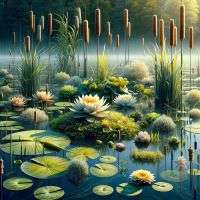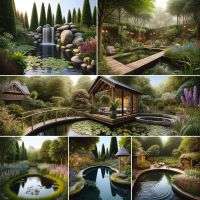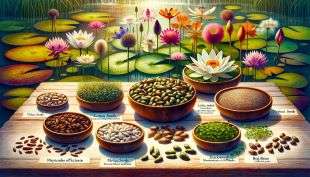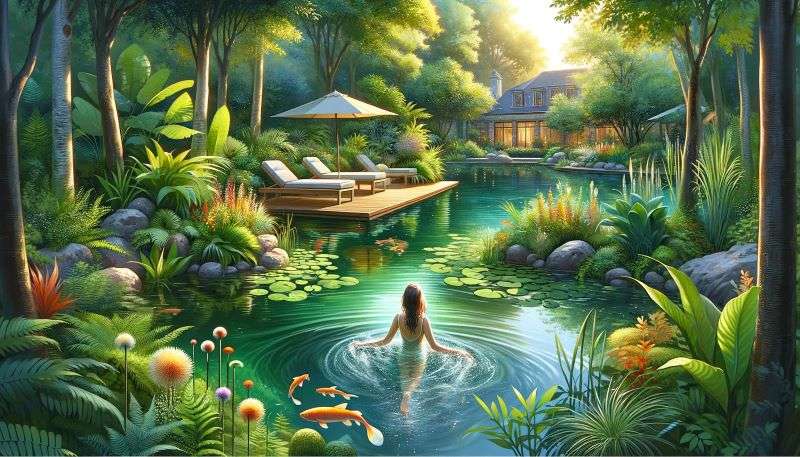This post contains affiliate links, through which we may earn a commission at no additional cost to you.
Table of Contents
Introduction
Begin your journey towards constructing the ideal natural swimming pond you’ve always envisioned, with this guide acting as your navigation tool into the peaceful, welcoming embrace of your water paradise. Envision crafting a refuge in your backyard, a place steeped in the tranquility of nature that not only provides a cooling haven on the hot days of summer but also stands as the lively center of your garden’s ecosystem. Visualize the calming sound of water softly brushing against your pond’s rim, the view of plants and animals flourishing together, and the delightful sensation of water against your skin.
This guide aims to lead you through each phase, from the initial idea to the final creation, ensuring that your natural swimming pond blends flawlessly with its environment, fostering biodiversity while offering a sustainable and attractive element. Through the advice and directions offered, you’ll effortlessly slip into a realm of contentment, enveloped by the peaceful beauty and verdant settings you’ve brought to life. Allow this to be your inducement to convert your outdoor area into a tranquil haven that captures the senses and nourishes the soul, with every instance in your natural swimming pond feeling like a piece of heaven on earth.
Why Opt for Natural Swimming Ponds?
Eco-conscious swimming havens emerge as a brilliant showcase of green innovation, presenting a lush alternative to the traditional chemically treated swimming pools by merging effortlessly with your garden’s natural scenery. These natural swimming spaces establish a perfect union between relaxation and the untouched allure of the wild, welcoming humans and native fauna alike to revel in their tranquil beauty. In contrast to their traditional counterparts, these havens are self-sufficient ecosystems that depend on the harmony of water plants and natural cleansing actions to keep the water clean and healthy, thus greatly diminishing the need for harsh chemical treatments.
This approach promises a more wholesome swimming experience for you and your kin and nurtures biodiversity by serving as a sanctuary for various water and land species. The architecture of a natural swimming pond, with its soft contours and integrated greenery, boosts the visual appeal of your outdoor area, transforming it into a dynamic landscape element that fosters recreational pleasure while supporting environmental harmony.
Journey to Pond Excellence
Crafting a natural swimming pond is akin to creating art, balancing aesthetic appeal with practicality. Here’s the blueprint for constructing a pond that’s as flourishing as it is beautiful:
Prime Location
Choosing a location that basks in the sunshine is critical for setting up your natural swimming pond. A generous amount of sunlight is essential for growing aquatic plants in the pond and helps keep the water crystal-clear. A brightly lit area guarantees that photosynthesis happens effectively, which is necessary for sustaining a vibrant ecosystem in your pond.
Moreover, keeping your pond at a distance from large trees is paramount; this careful positioning helps avoid the buildup of leaves on the water’s surface and reduces the risk of problems caused by invasive roots that might damage the pond’s structure and water purity. By considering these considerations, you are establishing the foundation for a flourishing natural swimming pond that not only boosts the visual charm of your outdoor area but also offers a tranquil and environmentally friendly haven.
Envisioning Your Ideal Pond
When planning the layout of your natural swim pond, it’s critical to thoughtfully approach its size and shape, ensuring it’s not only appealing to the eye but fully functional as an aquatic environment. It’s advisable to have depths hitting at least 2 meters in certain areas, not just to enhance the swimming experience but to help keep the water’s temperature consistent. Such consistency is vital for the swimmer’s comfort throughout the changing seasons. Moreover, it’s essential to integrate areas of shallowness in your pond design.
These shallow regions are crucial for the growth of aquatic plants, vital elements in the pond’s ecosystem. These plants are instrumental in naturally cleaning the water, filtering out impurities, and oxygenating it. This intricate connection between the water, plant life, and swimmers brings the magic of purification to life in your pond’s design. It merges the natural world with human enjoyment, transforming your pond into a vibrant, living water garden that serves as a sanctuary for both wildlife and a tranquil retreat for individuals.
The Enchantment of Purification
Natural swimming ponds maintain their clear appearance through a biological filtering process, which is critical for keeping their pure state. Setting aside a particular region for renewal is recommended, ideally covering about half of the intended swimming area. This renewal zone needs to be filled with a diverse range of water plants chosen for their natural water-cleansing properties.
These plants are vital to the pond’s ecosystem, taking up nutrients and pollutants that would otherwise lower the water’s quality. With this natural filtration mechanism, the pond not only preserves its health and transparency but also becomes a home for helpful microorganisms and insects, further enhancing the water’s purity and the overall ecological equilibrium of the pond. This mutualistic interaction between the water plants and the pond fosters a self-supporting, green aquatic ecosystem that flourishes with little human effort, representing the true nature of a vibrant water garden.
Selecting the Perfect Plant Mix

Choosing suitable plants is essential for your pond’s health and look. Below are five indispensable plants to include:
- Water Lilies (Nymphaea): They bloom beautifully and provide shade and a habitat for water life.
- Cattails (Typha): Ideal for the pond’s edges, they serve as natural purifiers.
- Water Lettuce (Pistia stratiotes): This surface plant aids in water cleanliness and offers shelter for fish.
- Hornwort (Ceratophyllum demersum): An underwater plant that oxygenates the water.
- Marsh Marigold (Caltha palustris): Brightens the water’s edge and attracts pollinators.
To delve deeper into the intricacies of creating a natural swimming pond, especially when it comes to selecting the suitable plant types that thrive in aquatic environments and identifying the best places to purchase them, consider broadening your knowledge with resources like “The Natural Swimming Pond Handbook” by David Pagan Butler. This comprehensive guide sheds light on the eco-friendly aspects of pond creation, including plant selection. Another invaluable resource is “Natural Swimming Pools: Inspiration for Harmony with Nature” by Michael Littlewood offers a deep dive into the design and maintenance of chemical-free water gardens, emphasizing harmony with the natural landscape and providing a wealth of design inspirations.
Additionally, “The Living Pond: Water Gardens with Fish & Other Creatures” by Helen Nash delves into the symbiotic relationships within aquatic ecosystems, offering practical advice on integrating fish and other wildlife into your pond for a truly natural experience. These books, alongside the previously mentioned titles, serve as invaluable guides, offering a blend of practical advice, design principles, and ecological insights to help you create a natural swimming pond that is not only a haven for you but also for the local flora and fauna.
Exploring Inspirational Pond Designs
Consider these five natural swimming pond designs that brilliantly capture the essence of an aquatic utopia:

- The Rustic Haven: Set in a forested garden, featuring a stony cascade for a tranquil auditory experience.
- The Contemporary Refuge: Boasts a minimalist design with neat lines and a spacious area for swimming, edged by sophisticated aquatic flora.
- The Cottage Core Fantasy: Characterized by a whimsical, natural-shaped pond bordered by wildflowers and a charming wooden bridge.
- The City Haven: Demonstrates how compact urban gardens can be converted into a serene escape.
- The Playful Family Zone: With several shallow spots for children’s safety, this pond is ideal for family fun.
Essential Reads for Pond Aficionados
To delve deeper into the intricacies of creating a natural swimming pond, especially when it comes to selecting the suitable plant types that thrive in aquatic environments and identifying the best places to purchase them, consider broadening your knowledge with resources like “The Natural Swimming Pond Handbook” by David Pagan Butler. This comprehensive guide sheds light on the eco-friendly aspects of pond creation, including plant selection. Another invaluable resource is “Natural Swimming Pools: Inspiration for Harmony with Nature” by Michael Littlewood offers a deep dive into the design and maintenance of chemical-free water gardens, emphasizing harmony with the natural landscape and providing a wealth of design inspirations.
Additionally, “The Living Pond: Water Gardens with Fish & Other Creatures” by Helen Nash delves into the symbiotic relationships within aquatic ecosystems, offering practical advice on integrating fish and other wildlife into your pond for a truly natural experience. These books, alongside the previously mentioned titles, serve as invaluable guides, offering a blend of practical advice, design principles, and ecological insights to help you create a natural swimming pond that is not only a haven for you but also for the local flora and fauna.
Cultivating Success: Starting With Seeds
Initiating your pond’s plant ecosystem from seeds can be especially gratifying. Here are five kinds of seeds to kick-start your aquatic garden:

- Water Lily Seeds: For those signature flowers and pads.
- Lotus Seeds (Nelumbo nucifera): Introduces exotic beauty with breathtaking blooms.
- Watercress Seeds (Nasturtium officinale): A dual-purpose choice, both purifying and edible.
- Duckweed Seeds (Lemna minor): A swift-growing surface plant combating algae.
- Bog Bean Seeds (Menyanthes trifoliata): Ideal for the shallows, providing distinctive foliage and blooms.
Choosing the right seeds for your water garden is crucial, as it’s important to pick those that align perfectly with your area’s climate and the specific characteristics of your pond. Making such thoughtful choices guarantees that the plants will settle in well and enhance both the visual appeal and the vitality of your aquatic feature.
Esteemed marine plant nurseries, known for their expert advice and wide variety of plant species, and online gardening stores offering a vast selection of seeds and the added perk of delivering them directly to your doorstep are the go-to places for sourcing these seeds. By leveraging these outlets, you gain access to a carefully chosen array of aquatic plants designed to beautify and bring ecological harmony to your pond, enabling it to become a thriving haven that reflects the essence of nature.
Conclusion
Embarking on the endeavor to create the permaculture natural swimming pond you’ve always imagined is a thrilling venture that effortlessly merges creative planning with a dedication to the environment. By carefully choosing an ideal location, shaping the design to fit the curves of your garden naturally, and selecting water plants that flourish in your area’s climate, you lay the foundation for an enchanting retreat in your backyard. When I establish my permaculture farm, having a natural swimming pond will be an indispensable feature, embodying the principles of ecological harmony and sustainable living at its core.
Gaining inspiration from successful projects while adding distinctive features, such as initiating your water garden with seeds, guarantees that your pond reflects your commitment to harmonizing relaxation with environmental integrity. Approach the project zealously, and seek professional advice to sharpen your insight and approach. As your natural swimming pond takes shape, you’ll discover that you’re creating a piece of heaven, a symbol of the harmony between nature and creativity, making every minute spent in your outside haven a step towards ultimate joy.
FAQs
How do you maintain a natural swimming pond?
Regularly remove debris, balance plant life, and monitor water quality to maintain clarity and health.
Can you heat a natural swimming pond?
Yes, using solar covers or installing a solar water heating system can gently raise the water temperature.
Are natural swimming ponds expensive to install?
Initial costs can be higher than traditional pools, but long-term maintenance costs are often lower due to natural filtration.








